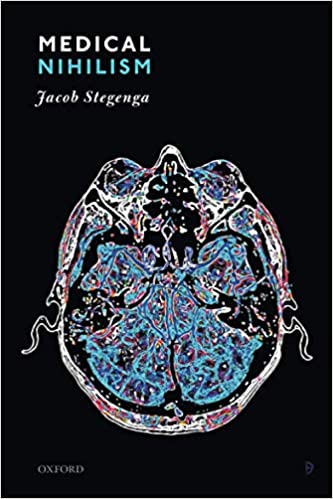Jacob Stegenga
Oxford, UK
Oxford University Press
2018
226 pages
According to the art:
Stegenga offers a book-length and formal philosophical explanation using Bayes Theorem on why “we should have little confidence in the effectiveness of medical interventions.”
Synopsis:
“Modern medicine is amazing,” is how Jacob Stegenga starts this book. Four sentences later, he ends the first paragraph with, “We should have little confidence in the effectiveness of medical interventions.” (p. 1) How is this? He provides a book-length explanation of how the occasional, amazing, “magic bullet” should not obscure the reality that most medical interventions fail to deliver “the highest value of medicine, [which] is the elimination of symptoms of disease and ideally the elimination of disease itself and thereby the achievement of health.” Stegenga calls this viewpoint “medical nihilism,” based on nihilism as “the denial that some particular kind of value, abstract good, or form of meaning in life exists.” (p. 6)
Stegenga does not lay claim to the term, and covers some of its history going as far back as the ancient philosopher Heraclitus and up through more recent nihilists such as Ivan Illich. His use of the term draws mostly from “therapeutic nihilism” of the nineteenth-century because then it concerned interventions corresponding with his focus on current pharmaceutical interventions, which serve as the substrate for his thesis. He notes the well-known Oliver Wendell Holmes, Sr quote from 1860: “if the whole materia medica, as now used, could be sunk to the bottom of the sea, it would be all the better for mankind—and all the worse for the fishes.” (p. 11) Many more are offered from the likes of Shakespeare, Montaigne, and Nietzsche to further his point about the entrenchment of medical nihilism over the centuries.
Stegenga is a philosopher of science, and as such, he constructs a formal case (“master argument”) for medical nihilism. He builds the argument from conditional probabilities in the form of Bayes’ Theorem.
P(E|H)P(H)/P(E)
“H” represents the hypothesis “claiming” a medical intervention is effective, and “P(H)” is the probability that the intervention is effective. “E” is any evidence associated with the intervention, which through “error, bias, and fraud…systematically slants [it] toward the production of evidence that suggests that a medical intervention is effective.” (p. 177) “P(E),” then, is the probability that evidence favoring the hypothesis of effectiveness exists, whether the hypothesis is true or not. “P(E|H)” is the probability of observing supportive evidence given the hypothesis is true. When spelled out:
P(observing supportive evidence given the hypothesis is true) x P(intervention is effective) /
P(evidence favoring the hypothesis of effectiveness exists, whether the hypothesis is true or not)
Stegenga assigns qualitative probabilities based on prior knowledge, experience, and research: P(E|H) is low; P(H) is low; and P(E) is high. The relationship of these (prior) probabilities, according to the Bayesian formula above, represents the master argument: the probability a hypothesis suggesting a medical intervention is effective given evidence to that effect—P(H|E)—is low.
Most of the book comprises analyses and judgments he used in assigning these prior probabilities. The book is divided into three main sections: 1) Concepts; 2) Methods; and 3) Evidence and Values.
Stegenga identifies the key elements of his analysis in the Concepts section. One is how he characterizes the basis for judging medical intervention effectiveness. For this purpose, disease is a health problem with a “causal” (e.g., pathophysiological) or a “normative” basis (e.g., harmful effect). He recognizes that assessing prior probability for effectiveness of medical interventions as they apply to these disease criteria may be too narrow. As a result, his master argument might not reflect the probability of effectiveness for other applications of medical interventions such as “cosmetic surgery, abortion, and contraceptive practices.” (p. 52)
In this section, Stegenga also establishes historical “magic bullets” as the metaphorical benchmark for medical intervention effectiveness. A magic bullet, for his purposes, targets the causal or normative basis of a disease specifically, and “improves the health of the person treated to near normality.” (p. 56) Stegenga points repeatedly to insulin and penicillin as archetypes, and laments that “there have been few magic bullets introduced since.” (p. 55) If the magic bullet serves as a proxy for medical intervention effectiveness in Stegenga’s formulation, then it stands to reason the prior probability for a hypothesis expecting medical intervention effectiveness is low. He contrasts magic bullets to many examples of pharmaceuticals with eye-popping utilization and costs that produce little to no benefit such as statins for heart disease, SSRIs for depression, alendronate for osteoporosis, thiazolidinediones for type 2 diabetes, and oseltamivir for influenza among others. He goes further yet when referring to the many pharmaceuticals withdrawn from use because the harms they produce outweigh any benefits they may provide.
The Methods section gets to why Stegenga’s prior probability of evidence supporting the hypothesis is high. His basic contention is that the many “fine-grained decisions” made in the course of designing, evaluating, interpretating, and publishing evidence around a medical intervention yields a degree of malleability to them. “The result,” Stegenga asserts, “is that one can bend these methods in a variety of ways, and such bending is usually in the direction of overestimating the effectiveness of medical interventions and underestimating their harms.” (p. 16)
To support his case that malleability comes into play “in a variety of ways,” Stegenga considers not just the methods directly involving how effectiveness is measured with empiric data from clinical trials and meta-analyses (“first-order methods”), but also methods used for interpreting and applying evidence (“second-order methods”). These include quality-assessment tools for judging evidence and ranking schemes for conveying the quality or reliability of evidence generation methods. Examples abound for each and all showing how inherent malleability associated with them can produce overestimates of evidence supporting medical intervention effectiveness. Just some that Stegenga mentions are inclusion and exclusion criteria for subjects in effectiveness trials and studies in meta-analyses; attribution of causal or normative basis of disease; medicalization of common variances around normal states (e.g., shyness, sadness); assigning relative value and credibility to individual studies based on evidence hierarchies; reporting relative rather than absolute outcome measures; relying on indirect instruments and surrogate measures of diseases (e.g., cholesterol levels); and the practice of conducting multiple analyses on datasets in ways that can generate spurious results by chance (i.e., “p-hacking”).
Covered in the Evidence and Value section are situational factors favoring evidence generation showing medical interventions as effective. Stegenga identifies bias and fraud as important factors. He points to particular forms of bias: confirmation bias, design bias, analytical bias, and publication bias, but only lightly touches on fraud because it does not rise to the level of importance as the “exploitation of the subtler threats to truth” he covers. (p. 160) He emphasizes, however, that commercial involvement in medical interventions (i.e., profit motives) and conflicts of interest exacerbate these biases and “ought to place less confidence in medical research and the clinical guidelines that are based on such research.” (p. 164)
This section is also where Stegenga recapitulates his argument, and answers anticipated objections. He offers some ideas towards addressing in the inputs driving medical nihilism under the heading of “Gentle Medicine.” One is urging physicians to prescribe less—just don’t do something, stand there. Other ideas urge regulatory authorities to approve fewer interventions and medical researchers to shore up their methods, and even rethink their priorities. All of them contribute to another layer of nihilism.
Analysis:
Stegenga never returns to his assertion that modern medicine is amazing after his first sentence. He will leave many readers dispirited and in despair as a result. The general public enthralled with modern medicine will be befuddled; governments expending large chunks of their GDPs on modern medicine will be enraged; patients in need of modern medicine will be shattered; younger health care professionals under the spell of modern medicine will be incredulous; and older health care professionals well acquainted with modern medicine will be frustrated but reconciled.
Must it be that these and other constituencies of modern medicine come away from a well-formulated argument for medical nihilism as medical nihilists? Probably, but Stegenga leaves some hints on how such an outcome can be tempered and managed.
One hint emerges from Stegenga’s qualification of his formulation for medical nihilism.
The formal representation of the master argument is simply meant to unify the otherwise disparate arguments throughout this book. I do not pretend that the terms in the master argument can be precisely quantified, either generally or for a particular medical intervention. The conclusion of the master argument is necessarily vague.
p. 178
He goes further in his qualification to say that we can’t know how low our confidence in a new medical intervention should go before it’s abandoned in practical terms, i.e., not adopted for clinical use. And to discern a proper level of confidence is not context-free. In some situations, for example, clinical use of a new medical intervention with a low prior probability of effectiveness is justifiable when the consequences and stakes are grave otherwise.
Another hint is in the foundational components of Stegenga’s argument. “The master argument for medical nihilism is based on ontological, epistemological, and justificatory reasons.” (p. 177) These three components offer ways of reacting to the proposition that we should have low confidence in the likely effectiveness of any new medical intervention.
The ontological component of medical nihilism recognizes that while medical miracles can happen, the human capacity for fallibility and folly—the nature of our being— work against a perpetual production of these miracles and puts downward pressure on confidence in any one medical intervention being effective. The epistemological component refers to how we acquire knowledge about medical interventions. Many of the factors driving high confidence levels in new medical interventions are riddled with the epistemological problems Stegenga details (eg, malleability, evidence hierarchies, surrogate measures of effectiveness, “p-hacking”). Some of the inputs to medical nihilism serve more as justification for reasoning than philosophical principles. For example, bias and fraud are justifiable inputs for prior probabilities conveying low confidence in the effectiveness of any new medical intervention.
Apprehending the philosophical basis of Stegenga’s medical nihilism doesn’t change its premise updated from Holmes’ view that if the whole materia medica could be sunk to the bottom of the sea, it would be all the better for mankind—and all the worse for the fishes. But this understanding could adjust our expectations and spare us from chronic despair brought on by serial cruel hoaxes.



